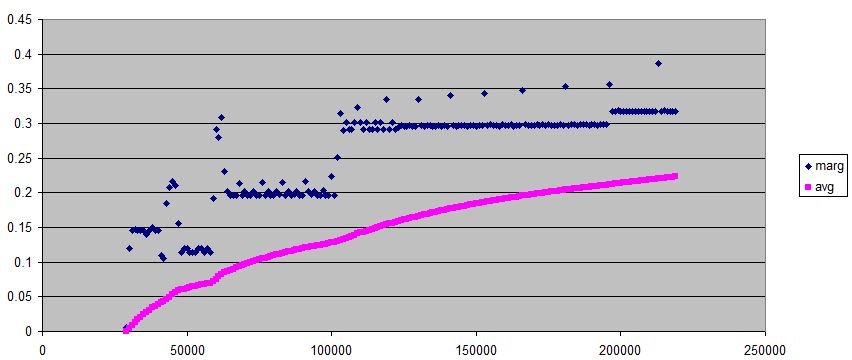Finance Dave
Thinks s/he gets paid by the post
- Joined
- Mar 29, 2007
- Messages
- 1,864
Given the two-year suspension of the cliff, I'm thinking of doing the below...thoughts?
We have been managing MAGI to stay under the cap...successful so far. A few facts to help:
1) Most of our savings is in tax-deferred plans
2) We spend about $80-90k/year, and have income from PT w*rk and rental properties of about $40k, so we need another $45 or so from somewhere.
3) We have very little cash cushion, as we don't want to lose the large subsidy on HC by taking too much out of the TIRAs and increasing our MAGI.
4) I'm 60, DW 63
5) We have 5 paid-for rental properties, and would like to sell them off slowly over time. To make math easy, let's say we'd make a profit (on tax return) of about $70k on each one.
With this suspension, I'm thinking we do the following:
1) Take out $150k from one of our TIRAs in 2021. This would put us at $190k income, but take the $24k standard deduction and we're back in the 22% bracket, right?
2) Then we take $14k of that money and fund Roth IRAs for 2021. Then on January 1st we can use another $14k to fund our 2022 Roth IRAs. (I do have enough "earned" income from my PT w*rk to be able to do this...barely lol)
3) Any left over could be either put in our joint checking to live on, or we can invest it in a standard investment account (not a retirement account) and transfer as needed to checking for living costs. We would likely invest this very conservatively or build a CD ladder or something.
2) In 2022, sell one or two rentals. If we sold 2, our income would be $140k plus $40 from work/rents for a total of $180k...and by the time you take off the $24k standard deduction we'd be in the 22% bracket, right?
Doing this for those two years would allow us to move a large chunk of our net worth to after-tax accounts, improve our liquidity, and minimize the impact on our subsidy.
Although I don't like the idea of jumping so heavily into the 22% bracket, I like the idea of losing the HC subsidy even less...it's about $15k/year for us. The one downside I see is losing the tax-deferred nature of gains on the large TIRA withdrawals, but we'd be taking that money out anyway slowly over the next 3-5 years to live on.
What am I missing or what other ideas do you have?
We do have Roth IRAs, but the balances are fairly modest (about $125k combined)....so we could use those each year to "manage" income also.
We have been managing MAGI to stay under the cap...successful so far. A few facts to help:
1) Most of our savings is in tax-deferred plans
2) We spend about $80-90k/year, and have income from PT w*rk and rental properties of about $40k, so we need another $45 or so from somewhere.
3) We have very little cash cushion, as we don't want to lose the large subsidy on HC by taking too much out of the TIRAs and increasing our MAGI.
4) I'm 60, DW 63
5) We have 5 paid-for rental properties, and would like to sell them off slowly over time. To make math easy, let's say we'd make a profit (on tax return) of about $70k on each one.
With this suspension, I'm thinking we do the following:
1) Take out $150k from one of our TIRAs in 2021. This would put us at $190k income, but take the $24k standard deduction and we're back in the 22% bracket, right?
2) Then we take $14k of that money and fund Roth IRAs for 2021. Then on January 1st we can use another $14k to fund our 2022 Roth IRAs. (I do have enough "earned" income from my PT w*rk to be able to do this...barely lol)
3) Any left over could be either put in our joint checking to live on, or we can invest it in a standard investment account (not a retirement account) and transfer as needed to checking for living costs. We would likely invest this very conservatively or build a CD ladder or something.
2) In 2022, sell one or two rentals. If we sold 2, our income would be $140k plus $40 from work/rents for a total of $180k...and by the time you take off the $24k standard deduction we'd be in the 22% bracket, right?
Doing this for those two years would allow us to move a large chunk of our net worth to after-tax accounts, improve our liquidity, and minimize the impact on our subsidy.
Although I don't like the idea of jumping so heavily into the 22% bracket, I like the idea of losing the HC subsidy even less...it's about $15k/year for us. The one downside I see is losing the tax-deferred nature of gains on the large TIRA withdrawals, but we'd be taking that money out anyway slowly over the next 3-5 years to live on.
What am I missing or what other ideas do you have?
We do have Roth IRAs, but the balances are fairly modest (about $125k combined)....so we could use those each year to "manage" income also.

